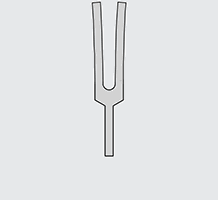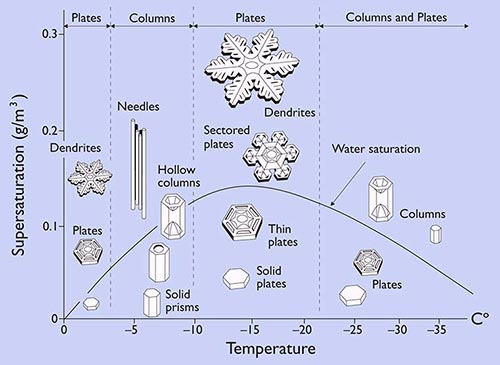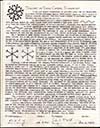Snow-Crystal Symmetry
Theory of Snow-Crystal Symmetry
This is a theory of snow crystal growth, and the similarity of branches within a single snow crystal.
Ice crystals, that make up snow flakes, are not injection molded or made with a 3-D printer, or any artificial means. There is no software to guide their shape, yet there is communication and coordination that forms six nearly identical branches within a single snow crystal.

As moisture freezes, crystalizes, and falls through the air, they randomly collide with other particles. Those collisions create shock waves that travel to the central nub and then radiate outward to all sides. The vibrations set up patterns that influence the shape of the water as it freezes.
Photos: Ken Libbrecht .
Studies exist to describe snow-crystal growth, the atmospheric conditions, the rate of growth, typical size and provide an explanation of why crystals are unique. However, no explanation has been found about why the branches of a snow crystal are essentially identical to the other branches of the same snow crystal.
 |
| A tuning fork produces an almost pure sine wave. |
Most objects produce vibrational patterns with irregularities called acoustical signatures. Think of the distinctive sounds of a metal wrench dropped on a concrete floor, a bouncing basketball, a spoon tapped on a water glass. The acoustical signature is unique for each object based on its material, size and shape.
The corollary is that moisture will freeze in a unique pattern in the presence of an acoustical signature. In this situation, moisture will freeze in nearly identical shapes on the six sides of the hub while collecting more building material (moisture) in the presence of an acoustical vibration, ex.: random collisions, and minute cracking, popping and squeaking sounds that occur during freezing. Like an airplane being built while in flight.
For example, if water freezes while holding a standing wave, it will retain that shape. On an ice crystal, a similar situation exists within the hexagonal geometry inherent in the 3-atom structure of an H2O molecule.
 |
An impact on any branch creates a shockwave that travels to the hub which in turn radiates outward to all six branches. If the acoustical signature from one branch is unique to that branch, then it follows that a vibration in that branch could give rise to the same shape in the remaining five branches. |
Mirror-image, or cookie-cutter symmetry?
When one tine of a tuning fork is struck, both tines vibrate in opposition repeatedly to create the note. The tines move as mirror images of the other about a central axis of symmetry. This suggests that there may also be this mirror-image effect between adjacent branches of a snow crystal.
 |
Rather than branches of a snow crystal being essentially identical, perhaps each is the mirror image of its neighbor. Since each branch has its own axis of symmetry, it may be difficult to determine if each branch is a mirror image or a cookie-cutter copy of its neighbor. Time-lapse video of snow-crystal formation seems to show growth on one branch being created on the opposite side of the adjacent branches in support of the mirror-image theory. |

References:
- “The Electrical Nature of the Development of Natural SnowCrystals”, Roald Schrack, 2018
- “Why are snowflakes symmetrical?“, Miriam Rossi, 2006
- “Freeze Frame”, Owen Edwards, 2005
- “Symmetry of Dendritic Snow Crystals”, Dan McLachlan, 1956
- “Snow Crystals, Natural and Artificial“, Nakaya, 1934
- “Snow Flakes“, Israel Warren, 1863
I welcome additional input from others who would like to discuss the similarity of branches of a snow crystal. Please contact Steve Hines at:
USA


